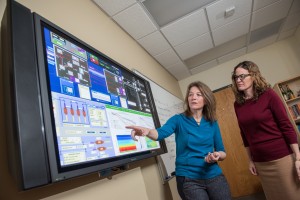
LIGO will for the first time directly detect gravitational waves, the ripples in the fabric of space-time predicted a century ago by Einstein with his theory of general relativity. Detecting and characterizing gravitational waves will unveil a new perspective of the cosmos, complementing the view provided by electromagnetic waves such as visible light, X-rays, radio, infrared and gamma rays.
Cadonati, currently chair of the LIGO Scientific Collaboration data analysis council, has joined the Center for Relativistic Astrophysics (CRA) in the Georgia Tech School of Physics. The center is devoted to interdisciplinary research and education linking astrophysics, astroparticle physics, cosmology and gravitational physics. In addition to Cadonati, the LIGO effort at Georgia Tech will also include Deirdre Shoemaker, an associate professor in the School of Physics and director of the CRA, and will involve close collaboration with Pablo Laguna, chair of the School of Physics.
In the search for gravitational waves, LIGO-related researchers at Georgia Tech will model sources of gravitational waves and analyze the large amount of data collected by LIGO. Their focus will be on those gravitational waves produced by transient cataclysmic events such as collisions of neutron stars and black holes.
Georgia Tech’s involvement will also include a high-performance computing facility and the construction of a remote monitoring facility with live data feeds from LIGO observatories in Livingston, Louisiana and Hanford, Washington. The campus facility will also provide training for scientists to learn the intricacies of the LIGO instruments and the complexities involved in the analysis of the data. The facility will also include a tabletop interferometer to be used for student training and outreach. Participation and leadership in the LIGO Scientific Collaboration will enable research opportunities for Georgia Tech faculty members working on big data analysis, optical interferometry and related technologies
Read full story here.